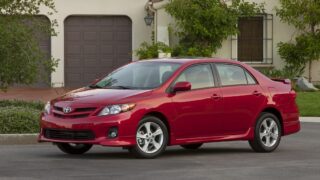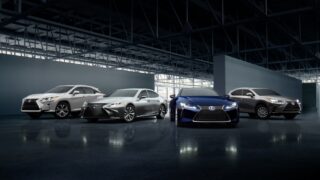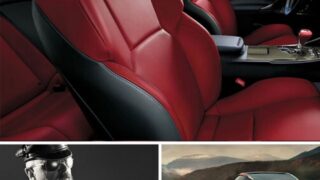Lexus RX History: Birth of the Luxury Crossover
How the Lexus RX — a vehicle built to capitalize on a marketing trend — became the best-selling Lexus of all time!
By the early 1990’s, compact and midsize SUVs were a common sight in America’s driveways. They were deftly reversing their reputation as top-heavy, impractical vehicles, thanks to suspension and body innovations. Crossovers have been around since the days of the AMC Eagle. However, they weren’t exactly competing in the same market bracket as a luxury passenger car. SUVs carried a certain stigma in the late 80’s, after all, even with cars like the Jeep Cherokee and S-10 Blazer. But by the mid-90’s, the SUV craze was thoroughly in vogue. Even so, the market still lacked an affordable luxury model – and Lexus was only too happy fill in the gap. But the story of the Lexus RX begins well before its design in 1995.
But first: What Even is a Crossover, Anyway?
The term “crossover” carries differing meanings depending on who you ask. It can range from any small-sized SUV produced in the late 90’s onwards, to any SUV with specific body construction. For argument’s sake, let’s say that a crossover has 3 important factors. Firstly, a crossover is a unibody platform. Second, the vehicle’s platform is shared with a regular car. And thirdly, the suspension is a compromise between the performance of a dedicated SUV and a sedan.
Early crossovers more closely resembled raised passenger cars, including progenitors such as the AMC Eagle (left) and VW Golf Country (right).
The SUV Craze Begins
Generally, compact SUVs were perceived as specialist vehicles. The likes of the Jeep CJ, Suzuki Samurai, Nissan Patrol, and Toyota Land Cruiser were all body-on-frame 4x4s. Most traced their lineage directly to the original World War II Ford GPW/Willys MB. However, in 1984, one vehicle would permanently alter the American perception of an SUV: the Jeep Cherokee. Borrowing its name from the full-size Cherokee, this newer, more compact vehicle was the first true unibody SUV. This unique construction afforded the Cherokee a lower center of gravity, more interior volume, and a far lighter weight than other vehicles in its class. Before long, this timeless design was joined by various contemporaries, including the Ford Explorer, Chevy Tracker, and more.
The one-millionth Jeep Cherokee rolled off the production line in 1990. When production ended in 2001, 2,884,172 units had exited the factory’s doors.
Before long, these vehicles began replacing cars such as minivans and full-size trucks for many families across the US. The vehicles effectively combined the usability of a passenger car with the cargo space and practicality of something larger. Automakers across the world marketed their own variants when sales started encroaching on passenger car purchases. By the mid-1990’s, the SUV craze was here to stay. Lexus, however, had another idea on how to capitalize on this trend.
An Eastern Philosophy
Toyota has a long history of producing outstanding SUVs, and was eager to get the foot in the door in this emerging market. Their first entry in the US market was 1994’s RAV4 – a compact, sporty vehicle with a unibody loosely based on the Carina and Corolla. Its initial launch in 1993 in Japan proved pivotal for the Lexus marque, however. While no one accuses the RAV4 of being a bad car, the higher-ups at Nagoya saw potential in expanding on the philosophy of a passenger car-based SUV. Toyota viewed their recently-launched Lexus marque as the perfect avenue for this revised formula. Lunchtime conversations were dominated with discussions of future plans. A rough philosophy was established and presented to the heads within the year. Needless to say, they liked what they were hearing.
The first-gen RAV4 had an electric variant, the RAV4 EV. Normally a fleet vehicle, the car was only on dealer floors for 7 months in California in 2003. Only 328 made it to the public before the program was canceled.
Planting Seeds
In 1989, Lexus debuted with two vehicles, the LS 400 (covered previously), and the ES companion car. The Lexus ES was based on a Toyota Camry Prominent, a Japanese-only premium package of the V20-series Camry. This original model was greatly overshadowed by its LS companion car, and didn’t fully come into its own until the second generation. Still retaining its Camry components, the mid-90’s were kind to the ES, showing record production numbers; in 1996, 40,735 units left the Tsutsumi plant. This was the car Lexus selected as the base for their new luxury crossover, marking the first time such a vehicle hit their design board.
The first (left) and second (right) generations of ES were the only Lexuses available with a manual transmission until 1998, when the IS was released.
The design principles of this new car were first proposed in 1994 to Toyota executives. The car was to be a mid-size luxury SUV based on the Camry/ES platform and retain a similar base price to the standard ES model. Furthermore, it’ll have similar fuel economy numbers, a spacious interior, and good visibility. To this end, designer Makoto Oshima penned a unique body style for the time. The angled rear A-pillar more closely resembled a midsize car’s with a wagon rear end attached. Much like the ES, the car sported a two-tone color scheme, and featured subtle trim elements over garish features. By 1995, prototypes were under construction, and testing was underway throughout 1996.
The SLV Concept
By February 1997, the vehicle was ready to be revealed to the public. Referred to as the “SLV,” the concept debuted at the Chicago Auto Show. The SLV closely resembled the finished product, being marketed as a car that combined the facets of an SUV and luxury sedan. Its target demographic was the American middle-class, being originally priced between $30,000 and $40,000 as a target. Even its name, Sport Luxury Vehicle, reflected its overall philosophy. Even at this early stage, it was clear that this wasn’t simply an uptrimmed Camry with raised ride height and an elevated seating position. The production name was selected later that year: RX, or “Radiant Crossover,” making it the first vehicle to use the term crossover in an official capacity.
The 1997 SLV’s 3.0L V6 engine was the first production V6 to feature continuously variable valve timing (VVTi).
Launching the First Luxury Crossover
The year 1997 saw the final revisions to the design before the car was soft-launched in Japan under a Toyota badge. In the Japanese domestic market, Lexus was still relatively obscure. No luxury Japanese marque, Lexus included, debuted in their home country until 2005 (which was Lexus, naturally). Instead, the luxury vehicles were generally produced under the original banner – the Lexus RX included. This vehicle, called the Toyota Harrier, marked the debut of the platform in December 1997. Functionally, the only difference between the production RX and Harrier was the latter was equipped with a 2.2L inline-four with the 3.0L V6 as an option; the RX was only available with the V6 at launch. This V6, the 1MZ-FE, was coupled to a 4-speed automatic and was available with either FF or AWD drivetrains.
Until 1983, Japan had a law stating that side-view mirrors must be within the viewable area covered by a vehicle’s windshield wipers, hence the fender mirrors. Many cars retained this tradition long after the law was abolished, such as the Harrier (pictured).
Headed Stateside
The Harrier proved successful in Japan, and the Lexus RX 300 (“300” denoting engine capacity) was poised for its entry into the US market. Debuting for the 1999 model year at $35,125 for FF or $36,925 for AWD layouts, the RX 300 quickly became Lexus’s poster child. It had all the bells and whistles that Lexus was well-known for boasting – LCD multi-function display, walnut trim, Pioneer sound system, the works. But it also didn’t sacrifice practical SUV features, either. Thanks to its unibody construction, ample cargo space was available with fold-down rear seating, and all seats were fully adjustable for plenty of legroom. The Lexus RX proved itself as a more practical alternative for the middle-class family looking for a luxury sedan, quickly overshadowing its ES cousin in dealerships.
The Lexus RX is more aerodynamic than many SUVs of the 90’s, with a drag coefficient of 0.36.
Into the New Millennium
The 2000 year saw a minor facelift for the car, which now sported revised headlights and the ubiquitous “Altezza” taillights. Sales of the RX 300 soared, with combined worldwide figures going over 370,000 within five years. These production numbers easily encroached on other luxury markets as well, overshadowing the Mercedes M-class by almost a factor of 2. Pretty soon, competing models such as the Acura MDX and BMW X5 started cropping up. This marked the beginning of the luxury crossover trend, an evolution of the SUV craze we touched on earlier. And Lexus was at the center of it all, enjoying a massive surge in popularity and directly contributing to Lexus launching in 2005 in the Japanese domestic market. The platform easily constituted 50% of Lexus’s sales by the time the second-gen RX was released in 2003.
Lexus released a Pebble Beach special edition for the 2009 model year; only 6000 units were produced. It featured unique cosmetics such as special 18-inch wheels and embroidered floor mats.
Today, the Lexus RX remains the top-selling luxury crossover in the US. It’s seen a number of innovations and revisions over 4 generations, as well as helming Lexus throughout its restructuring program. In addition, it was Lexus’s front-runner into the hybrid market, debuting as the 2005 RX 400h. While it’s sometimes perceived as an unassuming middle-class crossover, it’s easy to forget just how much it’s done for Lexus and the industry trends at large. It’s not too much of a stretch to say that without its success, Lexus would never have been able to separate from Toyota and develop its own in-house facilities. While overshadowed by Lexus’s more outlandish designs, the humble RX remains the solid pillar on which Lexus rests today and well into the 2020s.
Photos: Lexus
















